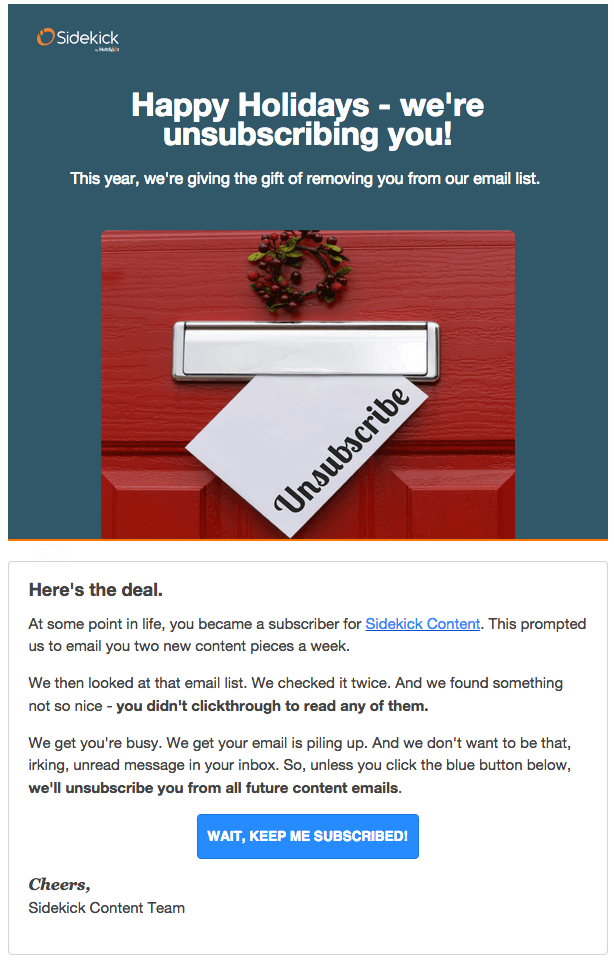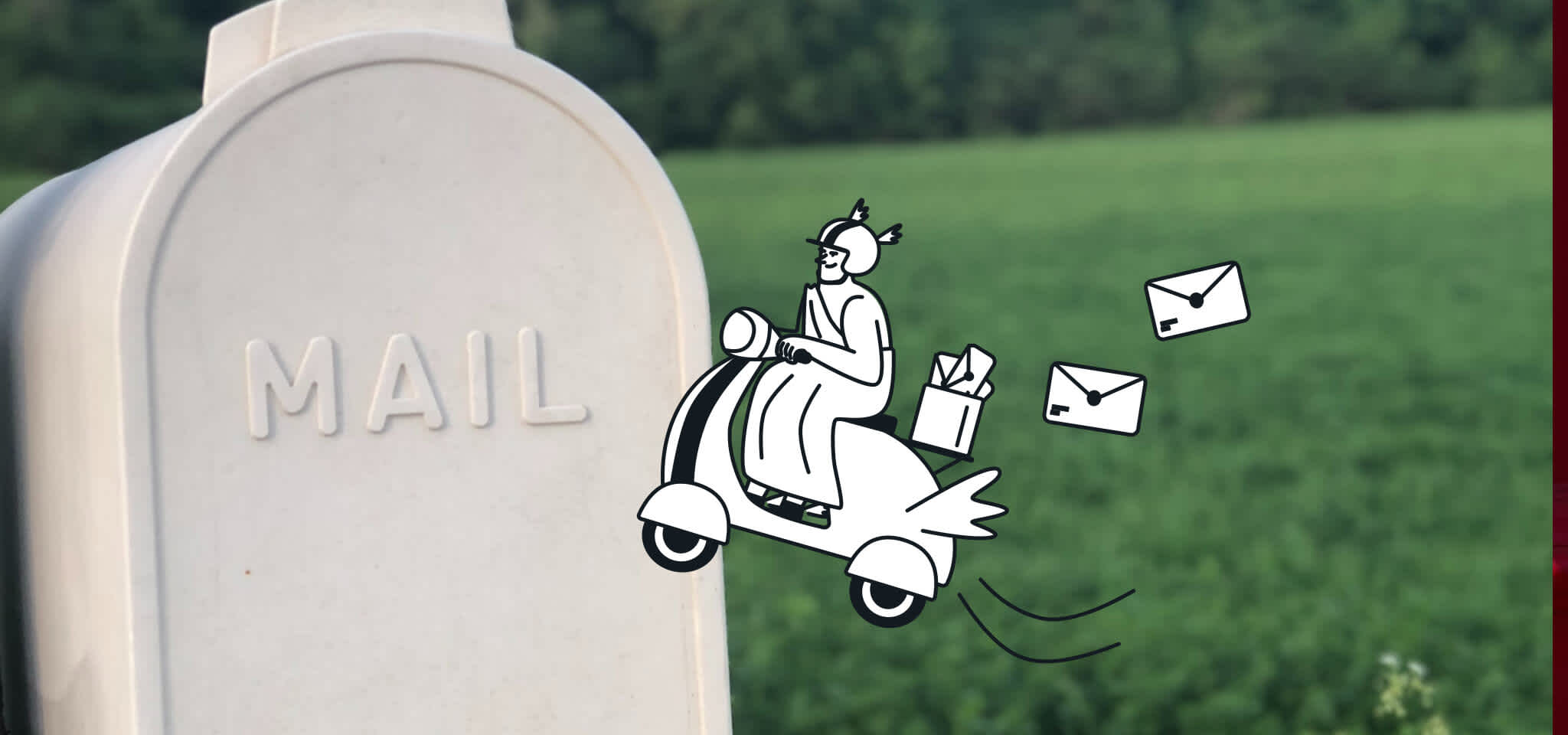Deliverability
Email scrubbing: Why and how to properly clean your email list
Find out what email scrubbing is and how it will improve your overall campaign performance. Discover 5 ways to maintain a healthy email list.

PUBLISHED ON
Spring cleaning is a drag. We get it. But just like it’s important you get rid of all those broken pens and loose paper clips in your desk, it’s also important to give your email list a thorough clean. The good news is you won’t need a vacuum for this one.
Table of contents
Cleaning your list after every email campaign
Cleaning your list every few months
1. Use a double opt-in
2. Go ahead and ask
3. Start a re-engagement campaign
4. Make it easy to unsubscribe
5. Never buy email lists
What is email scrubbing?
Email scrubbing means removing old or inactive contacts from your email database, be it contacts that are no longer engaging with your emails or dated email addresses that are no longer active and might return bounces, blocks or might have even become spam traps.
But wait a minute...isn’t it the more contacts on your list, the better chance you have for a higher opening rate? Actually, that’s not quite true.
Removing contacts from your list might seem scary. After all, you put in work to get them there in the first place. But placing your focus in nurturing the contacts who love your brand is the better way to go. Then you’ll be able to show them what your brand can really do.

A creative example here of an unsubscribe option Urban Outfitters
Why should you clean your email list?
Simply put, because it can impact your deliverability. That’s a fancy way of saying ‘the number of emails that make their way into your contacts’ inboxes, instead of the spam folder. Why should you care about this?
Two words, three syllables: email engagement.
The way ISPs (Internet Service Providers) learn is from your email statistics. They look at how subscribers are engaging with your campaigns through indicators such as open rates, click-through rates, and unsubscribes to gauge the interest in the content you’re sending. If your engagement is low, this tells the ISP that your contacts likely aren’t interested.
If this happens, ISPs could begin to mark it as spam, leading to fewer opens, fewer clicks, and lower engagement. It’s a vicious cycle, we know.
Now, scrubbing your email list won’t affect the total number of contacts that read your email; if 4 out of 100 open your email, the number will remain the same if 4 out of 50 contacts read it. The potential ROI from this campaign might remain the same, but email list cleaning will affect your reputation with the ISP. And this is key.
You don’t want a bad sender reputation (despite how cool the song by Joan Jett is). The worse your reputation is with an ISP, the more likely your mail will end up in spam. Then, because your emails are ending up in the spam folder instead of the inbox, the number of contacts reading your email will be reduced, along with your ROI and engagement. Email list cleaning is what’s going to help you avoid this.
There’s another reason to clean your list (as if you haven’t been convinced yet). By putting your time and focus into contacts that love your brand, instead of subscribers that never interact, you can build better relationships with your active customers. Focusing on the contacts that love your emails lets you create content that suits their needs and interests, which can lead to better conversion rates. You’ll have better customer satisfaction, and higher revenue. It’s a win win.
“Good list hygiene might be one of the things everybody forgets about, but it is so key to your success, and it’s something that can easily be done. You’re investing time and money into sending emails, and you want to make sure you’re taking care of the easiest things possible.”

Ashley Rodriguez
Deliverability Engineer II, Sinch
How to spot a list in need of cleaning
You should always clean your list from blocks, bounces and spam complaints after you send an email, but even if your emails are arriving in your contacts’ inbox, you might still be in need of an email list cleaning.
Essentially, the way to figure out if you need to clean your email list is to keep an eye on a decline in engagement metrics. If you see that they are decreasing over time, it might be time to clean that list.
This decline could be down to an abundance of old contacts that are uninterested or disengaged with your brand. These people are highly unlikely to open your emails.
If it’s not them, it could be bad email addresses that your messages bounce back from. Scan through your subscriber list with these two types of contacts in mind and start to scrub that contact list clean. Metaphorically, of course.
How to clean your email list
Ok, you convinced me, I know why I should clean my contact list and I’m ready to begin. But where do I start?
Don’t worry, we’ve got your back.
To clean your email list, you can use two methods:
Remove blocks, bounces and unsubscribes after every email campaign.
Use segmentation to target inactive users.
Cleaning your list after every email campaign
We promise it’s not as much work as it sounds. After each campaign, take a look over your stats. You'll want to look for unsubscribes, bounces and spam, and remove them from your contact list before sending another campaign. Diligence is key to cleanliness!
But, what else can you do to optimize your email contact list? Well, we’re glad you asked.
Cleaning your list every few months
You can also segment your list based on the engagement of your contacts. Look for the contacts that haven’t opened your email in the past 3 to 6 months and send them a ‘we miss you’ reactivation email.
It’s like checking in on an old friend. You send them a little message to see if you still have anything in common, and if they don’t respond… all that’s left is to move on and remove them from your contact list. Because, let’s face it, if they haven’t engaged with you in the past 6 months, the message they’re sending is pretty clear. They’ve lost interest in what you’re offering. But the good news is you are freeing up time and effort to focus on catering to the contacts that can’t get enough of you.

5 tactics to maintain a healthy email list
1. Use a double opt-in
A double opt-in means that when a customer signs up for your mailing list, you fire off an email asking them to confirm their subscription by following a link in the email. Setting up a double opt-in system helps you prevent fake email addresses from entering your database.
This means that only those that are interested in receiving your content will confirm the subscription, and there will be fewer bounces, blocks, etc. Think of it as a first defense for a cleaner and healthier list.
Interstingly, a recent survey from our Road to the inbox: Navigating email deliverability 2025 report found close to 40% of email senders are using a double opt in, but almost 48% say they do not and more than 12% are unsure.
Do you use a double opt-in process to confirm consent when adding new contacts to your list?
While a double opt in could mean your email list doesn’t grow as quickly, it protects you from the perils of poor engagement.
2. Go ahead and ask
It can be hard to tell if your contacts are simply not interested in what you’re sending them, or if they do, but just don’t feel like taking further action this time. A way to separate these two audiences is to ask questions. We have a couple of ideas for how you can do this. So go on, don’t be shy.
You can ask your contacts to vote in a poll, with a question about how much they are enjoying your content, or maybe what they would like to see more of.
Request some feedback on something you’ve sent, a new format you’re trying out, or anything else you’re curious about.
Ask your contacts to set their own communication preferences directly within the email. You can ask about preferred frequency, topics they might be interested in, etc.
Offer your contacts the ability to easily make product or feature requests.
Once you’ve sent out a round of these emails, filter out the contacts that are still not engaging with your content. Voila! A squeaky-clean list.
3. Start a re-engagement campaign
Remember when we were talking about those ‘we miss you’ emails? That’s a re-engagement campaign. Low engagement in your content doesn’t necessarily mean that your contacts aren’t interested in your brand, it could just mean they aren’t too interested in the content you’re providing.
So, before you scrub them from the list completely, see if you can pique their interest a bit.
We have a few ideas for you:
Offer a free gift, or maybe a discount. You’ll want to be careful with this one as while it has potential, what you really want is for your contacts to be interested in the content you’re providing, rather than just re-engaging for the freebee.
Give them a special perk or maybe access to special content. Everyone loves to feel special every now and then.
Another tip is to take a quick glance at the calendar. Sometimes, people love your content, they’re just being bombarded by emails because of the time of year. Like during the holiday season when they don’t want to open even one more email. Just make a note to re-engage with these contacts later on.
In this Email Academy session, Mailjet’s experts Roshni Shah-Chin and Stephanie Watson went through the process of creating and nurturing a high-quality email list and shared effective strategies to gain engaged subscribers.
4. Make it easy to unsubscribe
It’s never a good idea to hide your unsubscribe link from your customers, or to make the process of unsubscribing difficult, time-consuming or confusing. If they can’t find your unsubscribe link, or don’t want to take the time, they may just mark you as spam. You don’t want that, and we don’t want that for you.
We know it may seem backwards to offer your clients an easy way for them to leave. But, if you’re providing your contacts with quality content (which we know you are), then they won’t even look at that unsubscribe button. Just make sure to make it worth their time by providing worthwhile content.

5. Never buy email lists
Repeat after me: I will not buy email lists. Good. Now say it five times fast.
It may seem like a quick and easy way to build up your sender list, but don’t be fooled. It’s far better to build up your own list of subscribers that chose to receive your content.
A bought list is usually poor in quality. They aren’t targeted for your brand, so you’re not going to get good value from interacting with them.
They could also have something called spam traps in them. These are email addresses that used to be valid but will now get your IP address blacklisted for sending to them.
So, before you go to buy that list, remember all those annoying emails you got that you rolled your eyes at and sent to the junk folder. That’s not where you want your emails to end up.
How to clean your list with Mailjet
While Mailjet automatically handles unsubscribes, it is a good idea to regularly clean your contact lists so you can focus on the people who are most interested in your email.
We’ve put together a step-by-step process that Mailjet customers can follow to successfully remove bounced or blocked email addresses, as well as people who marked their campaigns as spam or simply unsubscribed.

Read through this step-by-step guide if you’re looking to maintain a healthy subscriber list within your Mailjet account.
Navigate email deliverability in 2025
Exclusive insights from our “Road to the inbox” report
Uncover even more from Sinch Mailjet’s original research into how senders are handling email deliverability. Explore survey findings from more than 1,100 respondents. Plus, get expert advice from email deliverability veterans that’s tailored to email marketers. Explore all the insights without filling out a form.








